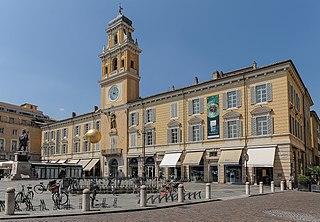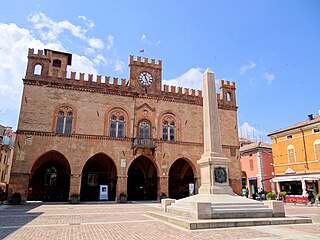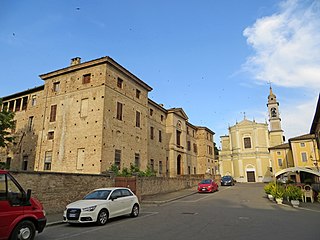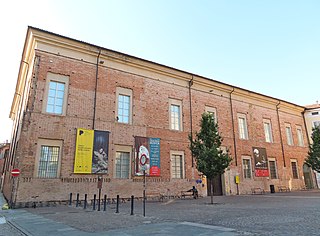
The Palazzo Pigorini is a small palace located on Strada della Repubblica #46, in central Parma, Italy.

The Palazzo Pigorini is a small palace located on Strada della Repubblica #46, in central Parma, Italy.
The palace as we see it now was mainly erected in 1767, although likely atop an older structure. It is a simple structure with a ground floor of large stone masonry, and simple stuccoed upper stories with four windows. The interior has a courtyard. The guilding is notable for housing in the past both the poet Angelo Mazza and the explorer Vittorio Bottego. In the mid-1800s, the piano nobile was frescoed with depictions of Night and the Apotheosis of the Poet by Francesco Scaramuzza. In the early twentieth century, the palace was acquired by Adriana Pigorini Lusignani, sister of a prominent archeologist, She left the building to the Commune of Parma, for use as a museum. [1]
The building was refurbished by Maurizio Bocchi, and is now used for exhibitions since 1996. [2]

Parma is a city in the northern Italian region of Emilia-Romagna known for its architecture, music, art, prosciutto (ham), cheese and surrounding countryside. With a population of 198,292 inhabitants, Parma is the second most populous city in Emilia-Romagna after Bologna, the region's capital. The city is home to the University of Parma, one of the oldest universities in the world. Parma is divided into two parts by the stream of the same name. The district on the far side of the river is Oltretorrente. Parma's Etruscan name was adapted by Romans to describe the round shield called Parma.

EUR is a residential and business district in Rome, Italy, part of the Municipio IX.

Fidenza is a town and comune (municipality) in the province of Parma, in the Emilia-Romagna region of Italy. It has around 27,000 inhabitants. The town was renamed Fidenza in 1927, recalling its Roman name of Fidentia; before, it was called Borgo San Donnino.

Terramare, terramara, or terremare is a technology complex mainly of the central Po valley, in Emilia, Northern Italy, dating to the Middle and Late Bronze Age c. 1700–1150 BC. It takes its name from the "black earth" residue of settlement mounds. Terramare is from terra marna, "marl-earth", where marl is a lacustrine deposit. It may be any color but in agricultural lands it is most typically black, giving rise to the "black earth" identification of it. The population of the terramare sites is called the terramaricoli. The sites were excavated exhaustively in 1860–1910.

Soragna is a town and comune in the province of Parma of northern Italy with a population of about 4,800.

Collecchio is a town in the province of Parma, Emilia-Romagna, northern Italy. It is located 12.9 kilometres (8.0 mi) by road southwest of the centre of Parma. A major food-producing area, it is home to multinational Italian dairy and food corporation Parmalat and the Parma F.C. training complex, Centro Sportivo di Collecchio, and is connected by railway. Under the Romans the town was called Sustrina, Later, in Christian times it was called, Colliculum, because of its location on a small hill. In 2015, Collecchio became recognized as the first community to mandate that all fireworks set off in the town be silent.

Fontanellato is a small town in the province of Parma, in northern Italy. It lies on the plains of the River Po near the A1 autostrada, about 20 kilometres (12 mi) west of Parma towards Piacenza.

Colorno is a comune (municipality) in the Province of Parma in the Italian region Emilia-Romagna, located about 90 kilometres (56 mi) northwest of Bologna and about 15 kilometres (9 mi) north of Parma.

Mezzani is a comune (municipality) in the Province of Parma in the Italian region Emilia-Romagna, located about 90 kilometres (56 mi) northwest of Bologna and about 15 kilometres (9 mi) northeast of Parma. The principal centres of the municipality are Casale, Mezzano Rondani, Mezzano Inferiore, Mezzano Superiore, whereas Bocca d’Enza, Ghiare Bonvisi, Valle are only hamlets. Mezzani borders the following municipalities: Brescello, Casalmaggiore, Colorno, Parma, Sorbolo, Torrile, Viadana.

Sala Baganza is a comune (municipality) in the Province of Parma in the Italian region Emilia-Romagna, located about 90 kilometres (56 mi) northwest of Bologna and about 12 kilometres (7 mi) southwest of Parma.
Dugenta is a comune (municipality) in the Province of Benevento in the Italian region Campania, located about 35 kilometres (22 mi) northeast of Naples and about 30 kilometres (19 mi) west of Benevento.


Luigi Pigorini was an Italian palaeoethnologist, archaeologist and ethnographer.

The Palazzo Comunale, also known as the Palazzo del Popolo of San Gimignano has been the seat of the civic authority in the comune since the 13th century. It is located on the Piazza del Duomo close to the Collegiate Church of the Assumption of the Blessed Virgin Mary. The building and Collegiate Church are at the heart of the medieval town, and are part of the UNESCO World Heritage Site of the "Historic Centre of San Gimignano".

The Palazzo Cusani is a palace at Piazzale San Francesco #1 in the central Parma region of Emilia-Romagna, Italy.

Pellegrino Strobel was an Italian ornithologist, zoologist, naturalist and Italian politician. He is considered among the leaders of Italian malacology and, with Gaetano Chierici and Luigi Pigorini, is an important figure in Italian prehistoric archaeology.

Sorbolo Mezzani is a comune (municipality) in the Province of Parma in the Italian region Emilia-Romagna. It was established on 1 January 2019 with the merger of the municipalities of Sorbolo and Mezzani.
Pigorini may refer to:

The Rocca Sanvitale or Sanvitale Castle of Sala Baganza is a fortress/palatial residence located on Piazza Gramsci #1, overlooking the small town of Sala Baganza, just southwest of Parma, region of Emilia-Romagna, Italy. It is distinct from the more-visited moated castle of Rocca Sanvitale, Fontanellato.

Palazzo Cornazzani is a palace in Pavia, in Lombardy, where, between 1895 and 1896, Albert Einstein lived.